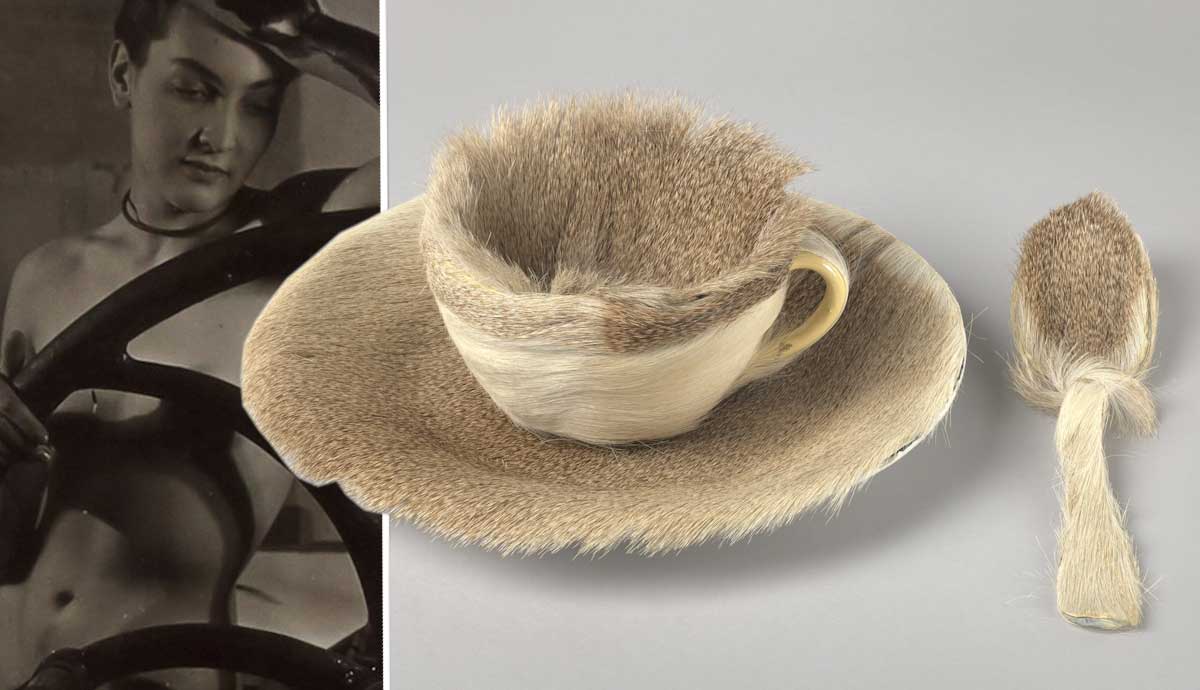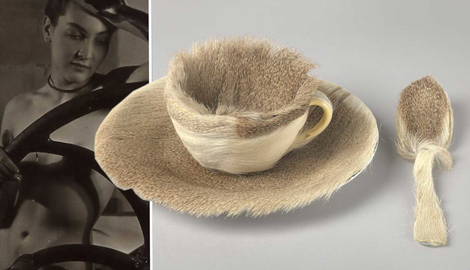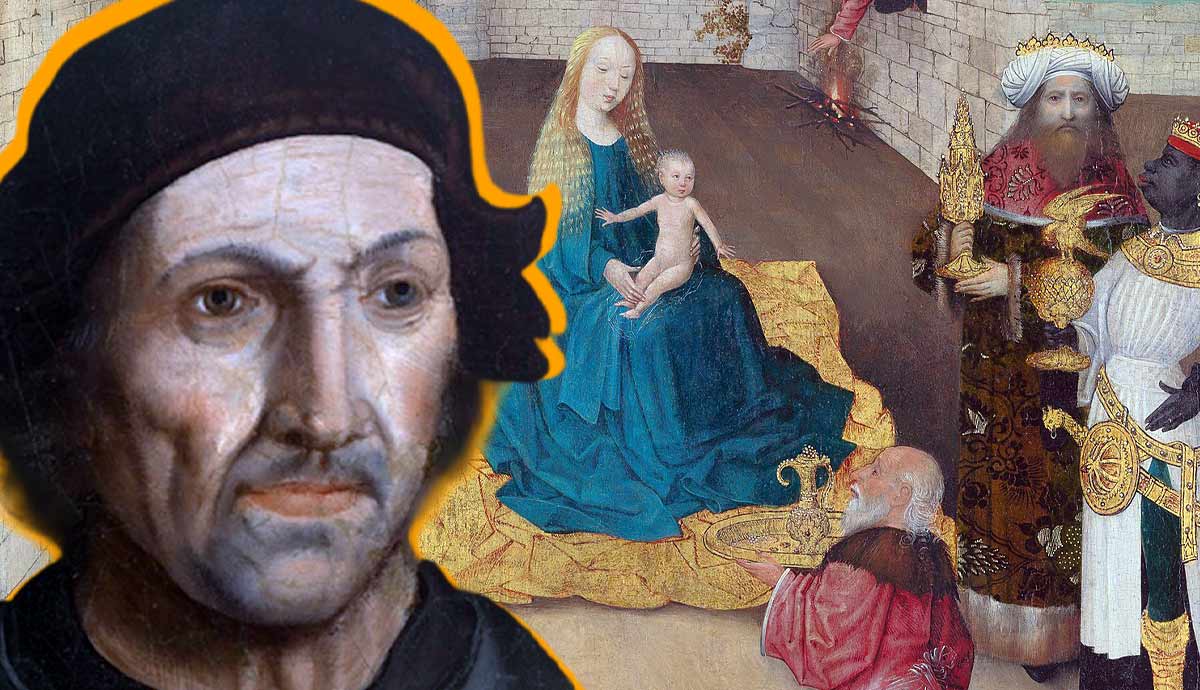
Meret Oppenheim was one of the most remarkable artists of Surrealism. Oppenheim was born in 1913 in a family of Swiss-German intellectuals. Her father was a progressive man, who encouraged his daughter to learn more about art, philosophy, and the latest scientific developments. Through his influence, Meret Oppenheim started reading the works of Carl Jung and recording her dreams in a diary, which she kept all her life. In fact, her detailed knowledge and deep analysis of Jung’s work set her apart from most of her colleagues.
Meret Oppenheim and Surrealism

Despite taking inspiration from Jung and Freud’s ideas, not many Surrealist artists actually spent enough time studying the works of these authors thoroughly. Oppenheim, however, did. She also augmented their theories with her female perspective.
Oppenheim started creating art in 1932. Just a year later, Alberto Giacometti and Hans Arp invited her to join the Surrealists. She was truly an interdisciplinary artist, working with painting, sculpture, poetry, photography, and even garment design. The legendary Surrealist photographer Man Ray called her the Surrealist muse but she was far from just a source of someone’s inspiration.
In Surrealism, the female figure was just another symbol. But Oppenheim and other women Surrealists like Leonora Carrington and Remedios Varo fought to change this by bringing their perspective into the genre. Here are 7 of Oppenheim’s works that you should know!
1. Object, 1936

Meret Oppenheim created her most recognizable and influential artwork in 1936 when she was only 23 years old. According to numerous people, the artwork originated after a conversation between Oppenheim and Pablo Picasso. In a conversation with young Oppenheim, Picasso mentioned that anything could be improved if covered in fur. Some historians see this remark as a harmless joke, while some see it as borderline-sexual harassment. The conversation allegedly resulted in one of the most recognizable pieces of art of the twentieth century.
Oppenheim purchased a teacup, saucer, and spoon in one of the Parisian department stores and covered it in gazelle fur. The elements used by the artist reference a particular social status. There’s expensive natural fur, fine porcelain, and the general practice of tea parties as a fancy social occasion. Combined together, these elements create a contradicting effect. Instead of elitist connotations, they evoke a feeling of disgust caused by the idea of wet fur touching a person’s lips. Moreover, the piece could be seen as an illustration of two sides of a woman’s personality: one civilized and decent according to society’s standards, and the other, free and wild.
2. Erotique Voilée, 1933

Oppenheim struggled to find her place in a male-dominated environment of Surrealism. Her desire was to be seen as an artist, and not as a woman. For Oppenheim, the human mind was androgynous and could not be affected by gender. In her efforts to be recognized as an independent creator in her own right, she mercilessly broke off relationships and associations that seemed harmful to her artistic voice.
The series of photographs Erotique Voilée made by Man Ray before Oppenheim became an established artist already showed the potential for her artistic voice. Nude and covered in ink, she was about to be crushed by a printing press wheel, but she remained calm and somewhat detached from the whole thing. The photograph illustrated the story Convulsive Beauty which was written by the Surrealist poet Andre Breton. However, in a true Surrealist manner, the image and the text had little in common, not accompanying each other but throwing the reader in disarray.
3. Sugar Ring, 1936-37

Meret Oppenheim’s oeuvre was built on unexpected juxtapositions and unlikely combinations of things. Her interest in jewelry design was also persistent throughout her entire career. Soon after making her groundbreaking Object, she moved forward to further explore different symbols and materials. Her work Sugar Ring was another experiment. It features a golden ring with a place meant for a massive gemstone, which was instead decorated with an object as simple and mundane as a cube of sugar. If you are a fan of Oppenheim’s work, you can still buy this piece today from a Swiss company Gems and Ladders, which specializes in replicas of jewelry designed by great Swiss artists.
While her artistic career was on the rise, Oppenheim’s personal life remained tumultuous. In 1936, she started a relationship with another famous Surrealist called Max Ernst. After a couple of months, Oppenheim ended the relationship unexpectedly out of fear of being overshadowed by the fame of her partner. After the breakup, Ernst referred to her as a sandwich stuffed with marble saying: “You have to be careful not to break your teeth when you bite into her.”
4. Fur Bracelet, 1936

Although Surrealism as a movement dealt with the subconscious creations of the human mind, some artists, including Meret Oppenheim, often created functional and wearable jewelry pieces, garments, and even furniture. The legendary fashion designer Elsa Schiaparelli frequently collaborated with emerging artists, including Alberto Giacometti, Salvador Dali, and Meret Oppenheim. Schiaparelli aimed to make unwearable objects wearable, creating fabrics that looked like tree bark or designing cauliflower-shaped buttons. Oppenheim, a promising young artist at the time, designed a collection of fur-covered bracelets and rings for Schiaparelli. Oppenheim started implementing fur into jewelry in the early 1930s, yet for several years she was the only person wearing her designs. Her collaboration with Schiaparelli continues to this day, with contemporary designs featuring elements from Oppenheim’s work.
5. Squirrel, 1969

After World War II ended, Meret Oppenheim decided to separate herself from the Surrealist movement, focusing on independent work that wasn’t bound by outside expectations. After a huge success and recognition that came to her in her early twenties, she struggled to create something of similar value to the outside world. During eighteen years of severe depression, Oppenheim worked as an art conservator. She tried to keep creating original works, yet most of her projects at the time were either left unfinished or destroyed by the artist.
Oppenheim’s artistic revival happened during the 1960s when several major cultural institutions presented her retrospective exhibitions. At the time, the artist distanced herself from her generation, instead preferring the company of young emerging artists. Propelled by new ideas and returning success, Oppenheim finally had the strength to create again. She continued to experiment with things living and dead, natural and artificial. The artist did not take herself too seriously, ironically referencing her earlier works, like in the case of the 1969 work titled Squirrel. Oppenheim used the same formula as in her famous Object, yet the result was completely different. A sturdy beer mug appeared in place of exquisite china, and the elegant gazelle was replaced by a squirrel’s tail.
6. Gloves, 1985

Surrealism as an art movement was integrated into the popular culture of the time, with artists working on brand advertisements and different collaborations. Meret Oppenheim was no exception. However, unlike Salvador Dali, she was extremely careful in her choices.
In 1985, Parkett Art magazine released a limited deluxe edition of their issue #4. There were 150 magazines that consisted of more than just printed pages. Inside the magazine, in a hand-shaped cutout, was a pair of thin suede gloves designed by Oppenheim. The gloves had embroidered veins on them. It looked as if, instead of covering the wearer’s hands, they were revealing more.
Meret Oppenheim worked with gloves throughout her whole life starting from her student years. Hands, and therefore, gloves, were one of the key symbols for the Surrealist movement. For Oppenheim, gloves were an attribute of a civilized woman who wore them to cover her true nature. Thus, the artist decided to reverse the process, creating glows with fur, animal claws, gills, or with veins.
7. Self-Portrait by Meret Oppenheim: X-Ray of My Skull, 1964

Meret Oppenheim was the rare representative of women artists of her generation who received praise during her lifetime. Although her work was appreciated (after all, Object was the first work by a woman artist bought by MoMA), it was frequently misinterpreted and fit into someone else’s narrative. Her work Spring Banquet, featuring a nude model covered with shellfish and fruit, serving as a living plate, was originally intended to be a celebration of fertility, nature, and womanhood. Yet, after Andre Breton convinced Oppenheim to include the work in a 1959 Surrealist exhibition, he renamed it. The new title Cannibal Feast outraged Oppenheim. A simple and joyful work was turned into another male fantasy. A celebration of a woman’s body was transformed into voyeuristic entertainment.
Despite all injustice and years of continuous struggles, Meret Oppenheim achieved the status of an iconic artist. Her explorations of the subconscious made an impact on the art of generations of groundbreaking creators, such as Louise Bourgeois and Marina Abramovic. During her interviews in the 1970s, Oppenheim repeatedly spoke against the discrimination of women artists, still outraged by the distortion of contexts and meanings in her own work.










